



[KESENNUMA, MIYAGI, JAPAN, 19 December 2011]
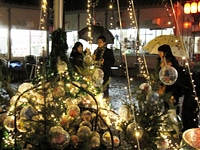 |
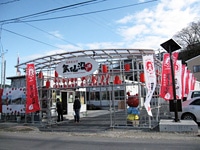 |
The UNICEF Prayer Tree Project was launched as a way for designers from diverse fields and art college students to cross their corporate and university borders and join hands to deliver smiles to the faces of Tohoku children on their first Christmas following the 11 March disaster.
On 3 December, an eight-meter “Big Prayer Tree” was set up in Kesennuma Yokocho (Kesennuma Alley) in Fukko Yatai Mura (Reconstruction Village) in Kesennuma City, Miyagi Prefecture. This is a special tree decorated with ornaments created by professional designers and a group of 2,000 art college students in efforts to convey the nation's prayers to the disaster areas. Prayer Trees appeared first in November at five locations throughout Tokyo (Ginza Mitsukoshi, Matsuya Ginza, SHISEIDO THE GINZA, Lumine Yurakucho, Yurakucho Loft) and two locations in Sendai (Sendai Mitsukoshi and Sendai Loft). The eighth Prayer Tree has now been erected in Kessennuma Yokocho, which opened on 26 November. ?Kesennuma Yokocho is lined with food shops that were damaged in the disaster and now operate under the hope of reconstruction. These grounds are also host to the “izuna no To”(Bond Tower), a large tower located at the center of the district. The tower was constructed to be eight meters in height, the same height as the tsunami that washed over Kesennuma, as a symbol for the village that expresses the memory of the disaster and the community's strong resolve to rebuild itself. On this occasion, a Prayer Tree donned with decorations befitting of the fishing town - utilizing fishing nets and glass fishing floats - was assembled on the site of the Kizuna no To.
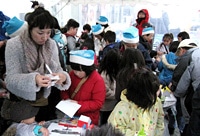 |
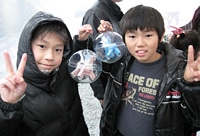 |
Before the new tree was constructed, a workshop was held where the children of Kesennuma were able to make ornaments for the Prayer Tree. Unfortunately, on the day of the event there was major rainstorm, but nevertheless by the event’s starting time of 10:00 a.m. children began to arrive at the venue. One girl showed up with her grandfather, having traveled on the morning’s first ferry from Oshima Island, an island in Kesennuma Bay. Each child immediately became absorbed in the task of designing their own ornament, and when they finished they proudly showed them off to their friends. The completed ornaments were inserted into rainproof capsules before the children were to place them on the Christmas tree. Staff and volunteers from the Kanagawa Association for UNICEF, who oversaw ornament creation and the placement of the tree, encouraged the children to decorate the tree in prayer of a quick recovery of Kesennuma. The children proceeded to carefully carry their new ornaments over to place them on the tree.
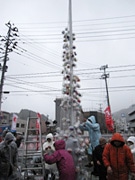 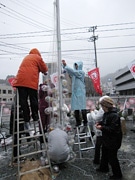 |
With the children’s newly crafted ornaments now in hand, efforts finally began for setting up the big tree. The weather was growing worse by the minute. Despite the rain and gale winds the group of staff from Kanagawa Association for UNICEF and 13 volunteers continued to work hard to set up the tree. First, an 8-meter by 20-meter piece of netting was spread out, and then the center was raised up like a flag to form the shape of a cone. The sides were decorated with illuminations, allowing it to take the shape of a Christmas tree. The tree’s base is a piece of fishing net provided by fisherpersons from Kesennuma, upon which ornaments made by creative designers and art college students from across Japan that participated in the Prayer Tree Project were placed one by one. After 400 ornaments were placed onto the tree by hand, the team began a process of gradually raising the fishing net. This process was repeated numbers times. The cold made it nearly impossible to move one’s fingers and the rain was so strong that everyone’s raingear proved useless. Nevertheless, everyone’s tireless efforts made it possible to finally raise the net close to the top. As everyone watched closely as the net went up, someone noticed that the net was beginning to tear near the top. That is when the unbelievable happened: the net dropped to the ground in a split second. Nobody could even speak. But the team’s motivation came from their promise to the children to have the tree ready by the 4:30 p.m. tree-lighting ceremony. Tirelessly, everyone joined in as efforts began again to re-set up the tree so that it could be completed within the day. Work lasted into the evening. Despite the grim weather and strong winds, which forced the concert scheduled to be held at Kizuna Square at Kesennuma Alley to be cancelled, and the falling of the net due to its heavy weight, the tree was completed in time for the tree-lighting ceremony.
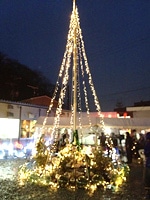 |
The countdown then began as crowds gathered at Kizuna Square for the tree-lighting ceremony. A giant "Ohh!" swept through the audience the instant the lights were turn on, illuminating Kesennuma's dark landscape. Catching sight of the strikingly tall and luminous tree, passers-by began to gather and stare in awe at the colorfully decorated ornaments. The tree had created a new sense of joy that the town could share.
The town of Kesennuma has few streetlamps and at night the scarred buildings leftover by the tsunami had been faint shadows in the town's murky streets. Now, however, the completed Prayer Tree stands tall for people to see from afar. Ms. Onodera, the head of Kesennuma Alley, smiled as she said, "This is sure going to pull people together!" One local resident commented, "Until now we didn't have anything cheerful to talk about. This is sure to energize the people." Another resident said, "It's almost like a light of hope." Upon hearing the joyous response of local residents, Kanagawa Association for UNICEF Director Sanami Tanisugi, who led efforts to set up the tree, commented that, "The fatigue from working tirelessly for nine hours in the pouring rain completely vanished at sight of the final product. I am so happy that we did what we did."
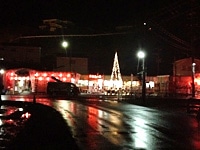 |
The Prayer Tree Project has been underway since May 2011.
This shining prayer tree continues to light the evening skies of Kesennuma today in honor of the designers and arts college students that created ornaments, the prayers of those that viewed the trees set up in Ginza, Yurakucho and Sendai, and those that stopped to enjoy the radiant spectacle.
All photo credits: © Japan Committee for UNICEF